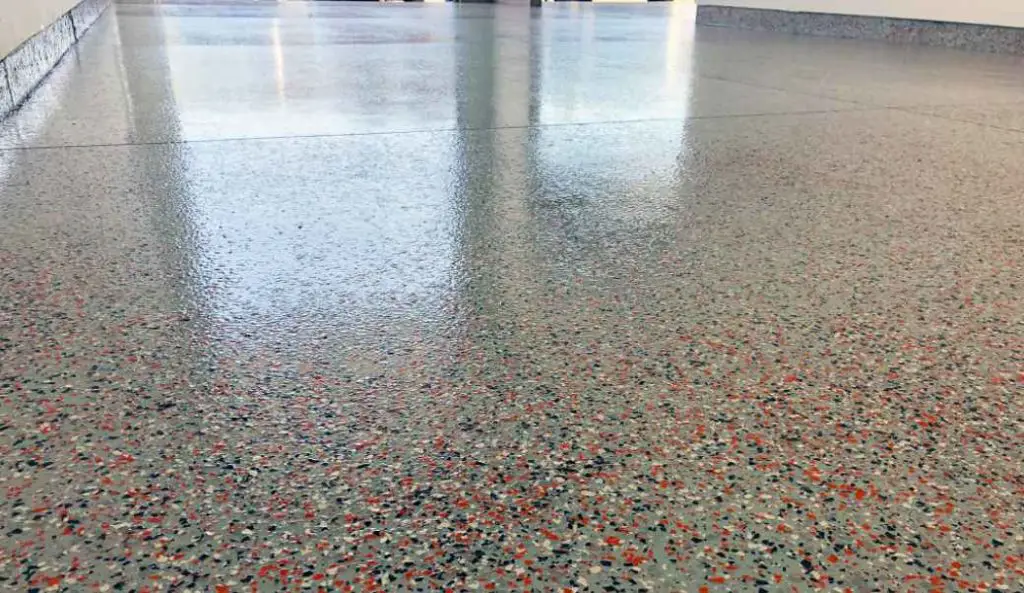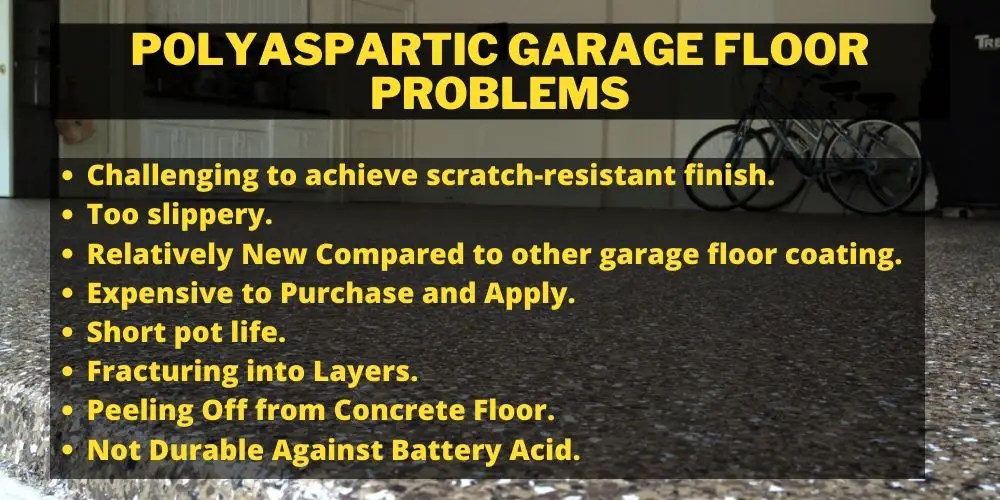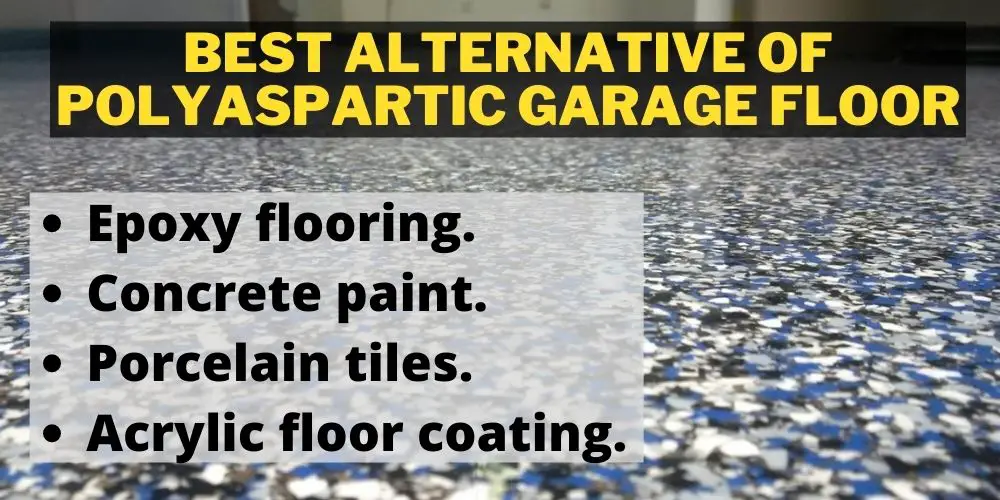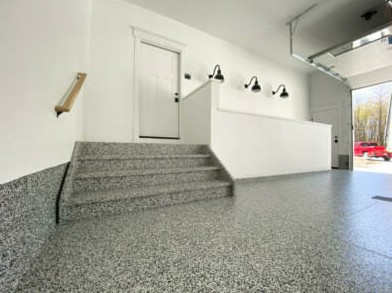Polyaspartic garage floor coating is one of the most popular options. However, a few issues might confuse or stop you from using this coating. Of all the significant problems this coating has, one is its extremely short pot life.
Not only does one risk losing the investment, but the result also may not be satisfactory. But thankfully, the situation can be brought under control by hiring professional help.

This article will look at such problems that you might face while using polyaspartic paint. In addition, we will talk about a few good alternatives and try to answer a few popular questions.
Polyaspartic Garage Floor Problems
Polyaspartic garage coating is quite popular. However, some concerns should be considered before you decide to coat your garage floor with Polyaspartic. In this section, we will look at some of those major concerns in detail so that you can determine whether or not to go ahead with it.

💁Challenging to achieve scratch-resistant finish
Though getting scratches on a Polyaspartic coated garage floor is difficult, it’s not impossible. The heavy-weight vehicles moving in and out of the garage might force dust and dirt into the coating, leading to multiple scratches.
Besides heavy vehicles, dragging heavy machines or other sharp-edged things on the floors can also lead to scratching. Thus it’s advisable to use a moving dolly for such equipment.
You will require regular flooring maintenance to keep such scratches from happening. Though this applies to dirt and dust, one of the best ways is to use a soft microfibre mop to clear the dirt and debris from the floor.
💁Too slippery
If you have not used non-skid addictives with your polyaspartic coating, slipping can be one of the major risks. The problem multiples when the floor is wet and can have dangerous consequences.
Thus it’s crucial to incorporate some form of traction into the coating. Material like quartz, sand dust, or vinyl chips can be used after a coat of primer during the installation process.
💁Relatively New Compared to other garage floor coating
Polyaspartic floor coating is new compared to the coatings that have been dominating the market, like epoxy. Owning to its relative newness, a lot of its characteristics are yet to be determined. Besides, if problems do arise after the installation process, it might be challenging to find the right people to fix the situation.
You May Also Find Useful: Polycuramine VS Epoxy
💁Expensive to Purchase and Apply
Polyaspartic floor coating also features multiple advantages like elegance, versatility, and style. However, all these come for a price, and the price is often out of budget for many. However, if you do have the budget, you can consider this coating.
Even if you buy this coating, its application process is not straightforward. The problem is felt significantly by DIY enthusiasts. Since the coating has a short pot life, a great deal of accuracy and speed is required to carry on the entire application process.
If the execution process is not done quickly and precisely, the whole investment in terms of cash and labor gets wasted. Thus it’s advisable to seek professional help when it comes to polyaspartic floor coating.
💁Short pot life
Polyaspartic coating has a characteristic quick curing trait. Depending on the formulation, the range of curing time is between five to twenty minutes. While it is challenging to complete the task in that span, on the other side, you can start foot traffic on the floor within 2-3 hours of installation and twenty-four hours for a car.
While that does sound like an advantage, the short pot life poses many problems. For starters owing to the short pot life, the material might simply dry in the bucket even before you begin the application process.
If such a situation occurs, not only will you be losing your investment in the expensive material, but the bubbles can get entrapped in the floor coating and lead to blemishes. You can avoid this setback by having installation accuracy in place. To that end, professional help is highly required.
💁Fracturing into Layers
Delamination is the cracking of the polyaspartic floor coating into two layers. Though there are multiple reasons for this occurrence, the high moisture levels are definitely one. When acid etching is conducted, surface penetration occurs during installation and results in moisture being added to the concrete.
Such an occurrence leads to lowering the pH levels and results in delamination. Floors yielding moisture and contaminants lead to polyaspartic coated floors to delamination.
This is common in comparatively new concrete floors that were not given the required time to dry before installing the polyaspartic material. Drying time is thus essential for a new floor and therefore must range from 28-90 days.
In addition to adequate drying time, other measures like diamond grinding coupled with vacuuming to get the floor clean must be followed.
💁Peeling Off from Concrete Floor
Peeling of the polyaspartic coating, often known as de-bonding, is yet another problem which results from faulty installation processes. If polyaspartic floor coating is applied to a concrete floor that repels moisture, then the chances of alteration of the adhesive in the coating is sure to happen.
The moisture leads to the loss of bond between the concrete floor and the polyaspartic coating and thus might result in the layer getting peeled. Besides humidity, other materials in the concrete floor like oil, grease, and other chemicals will undoubtedly result in the de-bonding of the floor.
The only way to avoid this problem is by conducting a surface penetration process carefully. The moisture level must be tested before applying the coating material.
💁Not Durable Against Battery Acid
Though polyaspartic floor coating is well known for its durability traits, it does not perform well against battery acid. If garage mechanics expect heavy traffic of vehicles with battery leaks cases, it’s best to avoid using polyaspartic flooring.
Best Alternative of Polyaspartic Garage Floor
To avoid polyaspartic garage floor problems, you can look for alternatives but you will realize that there are not many options available. Thus it’s crucial to pick one that will work with your requirement and be worth the investment. Below are a few options that you can consider.

💁Epoxy flooring
Though often referred to as paint, epoxy is quite different, combining a few different materials and chemicals. Epoxy paint is by far the most widely used option for coating garage floors. Epoxy floorings are durable, long-lasting, and result in an attractive coating that makes the garage stand apart.
💁Concrete paint
This is by far the most common floor coating that is used widely. Concrete paint is easy to use and provides vast coverage sealing most blemishes and stains. Besides, you have the option of multiple designs and colors to suit the rest of the interior.
However, compared to polyaspartic floor coating, paint does not hold for long. It’s also prone to scratching and peeling when exposed to moisture.
💁Porcelain tiles
Porcelain tiles are popular for their easy cleaning options and resistance to water and other liquids. Many people choose the unglazed version of these tiles to create friction preventing falls and slips. Like paint, porcelain tiles offer multiple colors and design options and are ideal for those looking to stylize their garage differently.
Despite the many benefits porcelain tiles offer, they don’t hold firm against impact and might chip if something heavy falls on them. Additionally, repairing such tiles is also difficult.
💁Acrylic floor coating
Though acrylic floor coating is also used for garage floors, they are not as durable as epoxy or polyaspartic floor coating. Thus, they need multiple recoats to attain the desired results.
However, the multiple recoats increase the installation cost, though it may not seem so expensive initially. Owing to these disadvantages, it’s best to use acrylic paint in areas with low foot traffic or low abrasions levels.
Are polyaspartic garage floors worth it?
Polyaspartic floor coating for garages, though proclaimed as a new technique, has been around since 1990. It’s often referred to as an effective paint for residential and commercial use, and that’s not without reason.
Firstly, it features high-end durability and resistance. Concrete floors often crack and break when exposed to continuous vibrations and pressure.
However, polyaspartic paint is made more robust and flexible. It can elongate up to 800%, enabling the coating to stand the test of time.

Polyaspartic paint covers all bases to be the perfect garage floor coating. It’s durable, UV stable, chemical, and abrasion-resistant and can thus function well in tough spots.
The performance level of polyaspartic floor coating is much higher. Besides, it has negligible VOC; thus, the cure time is much faster as well. Overall, its protective strength, resistance against chemicals and other fluids, and flexibility make it worth the investment.
Frequently Asked Questions (FAQs)
1. How long does polyaspartic last?
The longevity of a polyaspartic floor depends on the amount of wear and tear it absorbs. However, as a rule of thumb, it lasts for 10-20 years, depending on the traffic in the area and the installation process. The coating on a busy garage floor will have a shorter life span than one that does not get much traffic.
2. Does polyaspartic stain?
Polyaspartic floor coating is smooth and resistant to water and stains. The smooth surface does not allow any dirt or stain to settle on them, which makes the cleaning process easy as well.
3. Can polyaspartic be recoated?
Deglazing and recoating are required for improving the look of your floor; however, you can only do this if the existing coating is in proper condition. Recoating is not an option if it’s chipped, peeled, or cracked.
If your floor coating has got damaged, it’s essential to remove it entirely and apply a fresh coat. Prior to adding a fresh layer of coating on your polyaspartic floor is necessary to remove the top glaze so that the new layer can bond and hold well.
4. Is polyaspartic more durable than epoxy?
Yes. Though epoxy is durable, it’s vulnerable to chipping and scratches. Polyaspartic is more durable and resilient to chipping, scratching, and scuffing. Thus it’s surely more durable.
5. How many coats of polyaspartic do I need?
Most often, installers apply 2-3 coats for garage floors. The first layer gets into the cracks and functions as a sealant for the other layers. The second layer used is often pigmented and forms the base for the color chips or other decoration elements. The topcoat is the protective layer.
6. How long does polyaspartic take to cure?
Polyaspartic floor coating takes roughly 24 hours to cure for cars and vehicles to tread. Foot traffic can start for 2-3 hours of curing.
7. How long does polyaspartic smell last?
The fumes stay for 24 hours or so, but it’s thin out after that. It roughly takes 48 to 76 hours for the smell to ward off completely.
Summary
Choosing an ideal garage floor coating is not an easy job. Thus in this article, we have covered all the polyaspartic garage floor problems you might face if you choose polyaspartic coating.
However, despite the issues with this coating, it appears that it’s indeed a better choice than the rest of the options in the market. However, it’s advisable to consider all the pros and cons before taking your pick.
Contents

